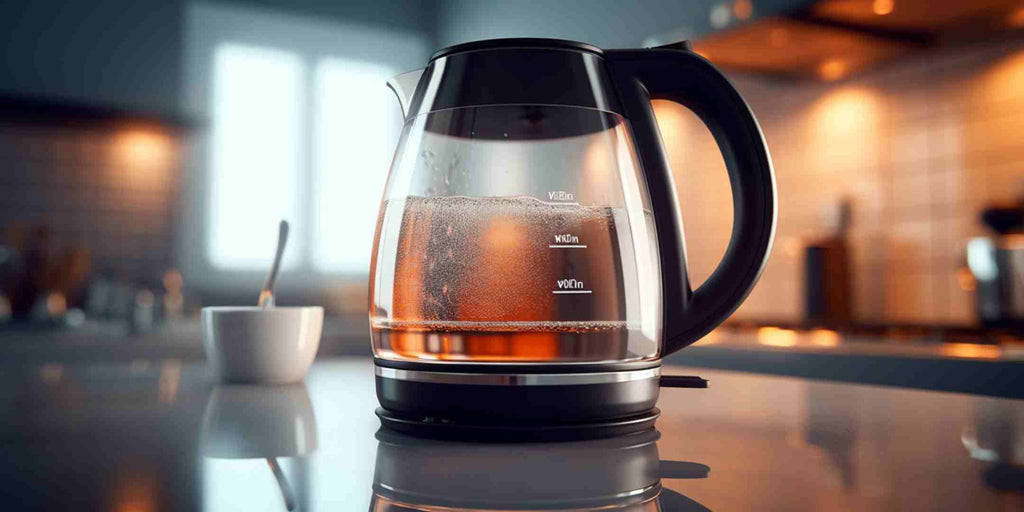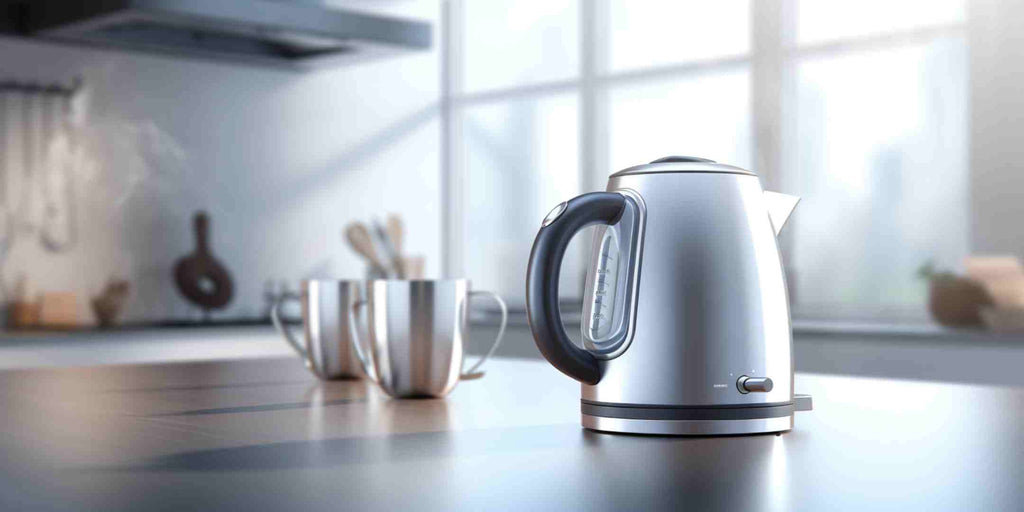For all tea enthusiasts, nothing ruins the morning ritual more than finding rust in their favourite electric kettle. It's a common enough challenge, and if "How to Remove Rust from Electric Kettle" has been your recent search query, you're in the right spot.
That perfect cup of tea deserves a spotless kettle. The significance of a clean kettle goes beyond aesthetics; it plays a pivotal role in ensuring every brew is as delightful as it should be.
But the real puzzle here is: why does our trusty kettle fall victim to rust in the first place?
Rust in electric tea kettles isn't just an eyesore; it can impact the taste and quality of your beverage. And while it might seem like a mysterious occurrence, there's science and reason behind its formation.
Stick around as Megafurniture unravel the mystery behind this common kitchen problem, ensuring you're well-equipped to keep that kettle in pristine condition.
How To Remove Rust From Electric Kettle With These Quick and Easy Methods
1. The Lemon-Vinegar Magic
One of the most tried-and-true methods involves things you already have in your kitchen: lemon and vinegar.
Steps:
- Fill the kettle with equal parts of water and white vinegar.
- Add a few slices of lemon for extra potency.
- Boil the mixture and allow it to sit for an hour.
- Pour out the solution and scrub gently with a non-abrasive scrubber.
- Rinse thoroughly, boil plain water in the kettle several times to remove any lingering taste, and voilà! A sparkling, rust-free kettle.
2. Cleaning the Elements
The heating elements are the heart of your kettle. Over time, they can accumulate not just rust but also mineral deposits.
Steps:
- Use equal parts water and citric acid (available in most grocery stores).
- Fill the kettle with this mixture, ensuring the elements are submerged.
- Boil the solution and then let it soak for about 30 minutes.
- Rinse thoroughly. A gentle scrub should do the trick if any stubborn rust spots remain.
Tea Kettles vs. Other Electric Kettles
Now, is every kettle different? Not quite. Tea kettles are designed explicitly for brewing teas and might have finer elements or be made of materials that react differently to cleaners. So, always ensure the cleaning method suits your kettle's material. While the above methods work for most, always do a patch test or consult the user manual.
Materials To Avoid
1. Bleach
While bleach is a potent cleaner, it's a big no-no for electric kettles. It can corrode the kettle's metal parts and leave residues that alter your subsequent brews' taste.
2. Steel Wool or Metal Scrubbers
These might seem like the go-to tools for stubborn rust, but using them can scratch the kettle's interior, leading to further rusting. Instead, opt for softer nylon brushes or scrubbers.
3. Harsh Chemical Cleaners
Products containing strong chemicals can be abrasive to the kettle's interior. They can also leave behind toxic residues. Always opt for food-safe cleaners when treating areas that come with your drink.
4. Salt
Although salt can be an effective abrasive in some cleaning scenarios, it can accelerate the corrosion process in metal kettles, leading to more rust.
5. Alkaline-based Cleaners
Avoid using alkaline-based cleaning agents if your kettle is made of aluminium or stainless steel. They can cause pitting and tarnishing of the surface.
6. Dishwashing Detergents
While they are great for greasy dishes, these detergents can be too harsh for delicate kettle materials, leading to discolouration or even damage over time.
Other Cleaning Hacks For Your Electric Kettle (You Might Find These Hacks Useful)

1. Combatting Limescale
Vinegar Mix: Use equal parts of water and vinegar. Fill the kettle, boil it, and let it sit for an hour. Empty, rinse, and you're good to go.
Citrus Magic: Not a fan of the vinegar aroma? Squeeze in some lemon juice instead. It’s nature's way of fighting off limescale.
2. Tackling Mineral Build-up
The Baking Soda Tactic: Add a teaspoonful to a water kettle, boil, and leave for several minutes. It’s like a spa day for your kettle.
3. Keeping it Fresh
To banish old odours, boiling water with a few lemon slices or a hint of vanilla extract works wonders. It’s like giving your kettle a refreshing scent makeover.
4. Sprucing up the Outside
Whether you've got a stainless steel gem or a plastic buddy, a dab of water and vinegar can make it gleam. A touch of olive oil does the trick for that extra sparkle on stainless steel.
5. Caring for the Base
The foundation of your kettle can gather dust and dirt. A simple wipe with a moist cloth, with the help of a cotton bud for those tricky spots, works wonders. Ensure it’s bone dry before reusing.
6. Filter Love
If your kettle boasts a filter, don’t forget to show it some love. A quick rinse usually does the job, but a gentle brushing can be handy for stubborn gunk.
7. Habitual Deep Dive
Even without visible grimy enemies, immersing your kettle in a thorough cleanse every month is a wise move.
8. Proper Storage Wisdom
After every clean-up, let your kettle air out completely. It wards off unwanted moisture and potential mold.
FAQs

How often should I clean my electric kettle?
While a quick rinse is recommended after each use, a deep clean to remove limescale and mineral deposits should be done at least once a month. You should do it more frequently if you have hard water.
Can I use regular dish soap to clean my kettle?
Yes, but use it sparingly and ensure you rinse the kettle thoroughly after cleaning to avoid soapy residue. For deep cleaning, natural agents like vinegar or lemon juice are preferred.
Is it safe to boil vinegar in my electric kettle?
Yes, boiling water and vinegar is a common and effective method to remove limescale. However, always ensure you rinse the kettle thoroughly afterwards to eliminate the vinegar smell.
I’ve heard about using cola to clean kettles. Does it work?
Cola contains phosphoric acid, which can help remove rust and mineral build-up. While it can work, it might leave a sugary residue. Sticking to vinegar or lemon juice is often better for a food-safe option.
My kettle has a plastic interior. Can I still use the vinegar or lemon method?
Vinegar and lemon juice are gentle enough for plastic interiors. Ensure you rinse the kettle well after cleaning to remove any lingering smells.
How can I prevent rust in my kettle in the first place?
To prevent rust, empty out leftover water and let the kettle dry completely before storing. Ensure it's placed in a cool, dry area. Using filtered water can also help in reducing mineral deposits.
The outside of my stainless steel kettle has fingerprint marks. How can I clean them?
A dab of olive oil or baby oil on a soft cloth works wonders. Rub in the direction of the steel's grain, and it should shine right up!
Can I use commercial descalers for my electric kettle?
Commercial descalers are designed to tackle limescale and can be effective. However, always read the labels to ensure they're safe for electric kettles and follow the manufacturer’s instructions. Rinsing thoroughly after descaling is crucial.
My kettle has a foul odour even after cleaning. What can I do?
Persistent odours might mean there's mold or mildew buildup. Boiling a mixture of water and baking soda can help neutralise odours. If the smell persists, it might be time to replace the kettle.
How do I know when to replace my electric kettle?
While regular cleaning can extend the life of your kettle, signs like inconsistent heating, lingering foul odours, a malfunctioning auto-shutoff, or visible damage to the heating element indicate it's time for a replacement.
Key Takeaway:
A kettle's cleanliness directly influences the quality of every brew. Just as a chef emphasises the importance of a clean kitchen for a delicious dish, a true tea lover knows the essence of a clean kettle for a perfectly flavorful cup of tea. The purity of the water, free from mineral build-ups and residues, ensures that the subtle notes and aromas of the tea leaves shine through in every sip. And isn't a delightful tea experience what we all seek at the end of a long day or the beginning of a fresh morning?
Additional Readings:
Electric Kettle Wattage: What Watts Mean for Boiling Speed
Interior Design Singapore: Best Firms for Your Next Home Renovation
Your Ultimate Cheat Sheet to Renovation in Singapore: HDB Guidelines, Procedures & Tips








